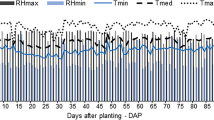Abstract
The purpose of this study is to develop combined irrigation systems for effective regulation of the hydrothermal regime of soil, plants, and the surface layer to create optimal conditions for plant growth and development. The fundamental methodological approach to creating combined irrigation systems is the combined use of different irrigation methods and their implementation in a special regime within a single technological process. Another key point is that irrigation is carried out in different ways on the basis of a single technical system, which is an independent design solution. The creation of these engineering systems is the starting point for the transition to new reclamation technologies providing an integrated regulation of life factors and an extended protection of agricultural crops from climate risks in open ground conditions. The research substantiates the necessity and technical feasibility for combining fine sprinkling irrigation of agricultural crops with other known methods of irrigation, such as drip, sprinkling, subsoil, and surface irrigation methods. Fine sprinkling covers the vegetative organs of plants with 100–400 μm drops, followed by their evaporation and the absorption of latent vaporization heat, which makes it possible to effectively regulate the microclimate in the sowing medium. During evaporation, water cools the leaf surface by 5–7°C and increases the actual humidity of the surface air by 14–16%, thereby removing peak temperature stress and improving the physiological state of the plants. However, under arid climate conditions with a severe shortage of natural moisture supply, fine sprinkling does not make it possible to compensate the demand of plants for water and does not regulate soil moisture reserves. This makes it necessary to combine the use of fine sprinkling with irrigation methods for soil moisture regulation.




Similar content being viewed by others
REFERENCES
Aleksandrov, A.D., Borodychev, V.V., and Chicha-sov, V.Ya., Fine sprinkling of potatoes, Zemledelie, 1978, no. 3, pp. 24–25.
Borodychev, V.V. and Lytov, M.N., Technical and technological foundations for regulating the hydrothermal regime of agrophytocenosis under irrigation conditions, Nauchnaya Zhizn’, 2019, vol. 14, no. 10, pp. 1484–1495. https://doi.org/10.35679/1991-9476-2019-14-10-1484-14952
Borodychev, V.V. and Lytov, M.N., Problems of optimal water supply of soybean under irrigation conditions, Izv. Nizhnevolzh. Agrouniv. Kompleksa: Nauka Vyssh. Prof. Obraz., 2019, vol. 2, no. 54, pp. 39–49.
Bocharnikov, V.S. and Meshcheryakov, M.P., New methods of cultivation of vegetable crops in the water-saving irrigation system, Ovoshchevod. Teplichnoe Khoz., 2014, no. 4, p. 54.
Dobrachev, Yu.P. and Sokolov, A.P., Models of plants growth and development and task of raising crops productivity, Prirodoustroistvo, 2016, no. 3, pp. 90–96.
Dubenok, N.N. and Maier, A.V., Development of systems of combined irrigation for watering crops, Izv. Nizhnevolzh. Agrouniv. Kompleksa: Nauka Vyssh. Prof. Obraz., 2018, vol. 1, no. 49, pp. 9–19.
Dubenok, N.N. and Maier, A.V., System of local intra soil irrigation of long-term plantings in the combination to aerosol moistening, Izv. Nizhnevolzh. Agrouniv. Kompleksa: Nauka Vyssh. Prof. Obraz., 2018, vol. 2, no. 50, pp. 157–164.
Zaikin, I.I. and Zaikina, A.K., On the development of fine sprinkling, in Sbornik nauchnykh trudov (Collection of Scientific Papers), Moscow: Vseross. Nauchno-Issled. Inst. Gidrotekh. Melior., 1978, pp. 67–70.
Kireicheva, L.V. and Karpenko, N.P., Evaluation of the efficiency of irrigation in a zonal soil sequence, Eurasian Soil Sci., 2015, vol. 48, no. 5, pp. 524–532.
Kurbanov, S.A., Maier, A.V., and Magomedova, D.S., Study of the drip irrigation system and fine sprinkler irrigation, Probl. Razvit. APK Reg., 2012, no. 3, pp. 5–9.
Shumakov, B.B., Kolganov, A.V., Borodychev, V.V., et al., Fine sprinkling of agricultural crops in the conditions of the Lower Volga region, in Sbornik nauchnykh trudov (Collection of Scientific Papers), Volgograd: Vseross. Nauchno-Issled. Inst. Okhot. Khoz. Zverovod., 1994, pp. 20–29.
Değirmenci, H., Tanrıverdi, C., and Arslan, F., Assesment of irrigated areas by sprinkler and drip irrigation methods in lower Seyhan plain, Kahramanmaraș Sütçü İmam Üniversitesi Doğa Bilimleri Dergisi, 2016, vol. 19, no. 4, pp. 454–461.
Goosheh, M., Pazira, E., Gholami, A., et al., Improving irrigation scheduling of wheat to increase water productivity in shallow groundwater conditions using aquacrop, Irrig. Drain., 2018, vol. 67, no. 5, pp. 738–754. https://doi.org/10.1002/ird.2288
Author information
Authors and Affiliations
Corresponding authors
Ethics declarations
The authors declare that they have no conflicts of interest.
Additional information
Translated by D. Zabolotny
About this article
Cite this article
Dubenok, N.N., Mayer, A.V. Long-term Studies of the Hydrothermal Regime of Agrocenoses and a Combined Irrigation System for Its Regulation. Russ. Agricult. Sci. 48, 123–127 (2022). https://doi.org/10.3103/S1068367422030053
Received:
Revised:
Accepted:
Published:
Issue Date:
DOI: https://doi.org/10.3103/S1068367422030053




